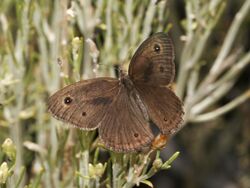Biology:Cercyonis sthenele
From HandWiki
Short description: Species of butterfly
| Great Basin wood-nymph | |
|---|---|

| |
| Cercyonis sthenele paulus, male | |
| Scientific classification | |
| Domain: | Eukaryota |
| Kingdom: | Animalia |
| Phylum: | Arthropoda |
| Class: | Insecta |
| Order: | Lepidoptera |
| Family: | Nymphalidae |
| Genus: | Cercyonis |
| Species: | C. sthenele
|
| Binomial name | |
| Cercyonis sthenele (Boisduval, 1852)
| |
| Synonyms | |
| |
Cercyonis sthenele, the Great Basin wood-nymph, is a North American butterfly in the family Nymphalidae.
Description
It is dark brown with two eyespots on the forewing with the upper larger than the lower.[3]
The wingspan measures 39–44 mm (1.5–1.7 in). Its flight period is from late June to late August.[4] It is found in arid woodland, especially pinyon-juniper, chaparral and brushland habitats.[1]
Similar species
- Common wood-nymph (Cercyonis pegala) – larger, eyespots similar in size
- Small wood-nymph (Cercyonis oetus) – lacks lower eyespot in males, lower eyespot is closer to margin than upper eyespot in females[4]
Subspecies
The following subspecies are recognised:[5]
- C. s. behrii (F. Grinnell, 1905)
- C. s. hypoleuca Hawks and J. Emmel, 1998
- C. s. masoni Cross, 1937
- C. s. paulus (Edwards, 1879)
- C. s. silvestris Edwards, 1861
- C. s. sineocellata Austin and J. Emmel in T. Emmel, 1998
- †C. s. sthenele (Boisduval, 1852) - nominate subspecies endemic to San Francisco Peninsula, now extinct[6][7]
Distribution
C. sthenele ranges over much of the western United States and reaches to southern British Columbia, Canada.[4]
Larval host plants
Larvae feed on various species of grass. The first instar hibernates.[4]
References
| Wikimedia Commons has media related to Cercyonis sthenele. |
- ↑ 1.0 1.1 "Cercyonis sthenele". https://explorer.natureserve.org/Taxon/ELEMENT_GLOBAL.2.107186/Cercyonis_sthenele.
- ↑ [1] Butterflies of America
- ↑ Brock, Jim P.; Kaufman, Kenn (2003). Butterflies of North America. New York, NY: Houghton Mifflin. ISBN 0-618-15312-8.
- ↑ 4.0 4.1 4.2 4.3 "Great Basin Wood-nymph". Canadian Biodiversity Information Facility. 2002. http://www.cbif.gc.ca/spp_pages/butterflies/species/GreatBasinWood-Nymph_e.php.
- ↑ "Cercyonis Scudder, 1875" at Markku Savela's Lepidoptera and Some Other Life Forms
- ↑ "ITIS Report: Cercyonis sthenele sthenele (Boisduval, 1852).". https://www.itis.gov/servlet/SingleRpt/SingleRpt?search_topic=TSN&search_value=779540#null.
- ↑ "Cercyonis sthenele sthenele. NatureServe Explorer 2.0". https://explorer.natureserve.org/Taxon/ELEMENT_GLOBAL.2.115903/Cercyonis_sthenele_sthenele.
Wikidata ☰ Q338175 entry
 |


